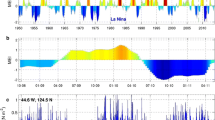Abstract
The sensitivity of the atmospheric circulation to an increase in ocean surface roughness in the Southern Hemisphere storm track is investigated in a paired general circulation model experiment. Such a change in sea roughness could be induced by ocean waves generated by storms. Two extended permanent-July runs are made. One with standard sea surface roughness, the other with ten times as a large surface roughness over open sea poleward of 40° S. The regional increase in ocean surface roughness significantly modifies the tropospheric circulation in the Southern Hemisphere. The strongest effect is the reduction of tropospheric winds (by 2 m/s or 10%) above the area with increased roughness. The poleward eddy momentum flux is reduced in the upper troposphere and the meridional eddy sensible heat flux is reduced in the lower troposphere. Zonal mean and eddy kinetic energy are consistently reduced.
Similar content being viewed by others
References
Arpe K, Brancovic C, Oriol E, Speth P (1986) Variability in time and space of energetics from a long time series of atmospheric data produced by ECMWF. Beitr Phys Atmos 59:321–355
Barnett TP, Preisendorfer RW, Goldenberg LM, Hasselmann KH (1981) Significance tests for regression model hierarchies. J Phys Oceanogr 11:1150–1154
Branscome LE, Gutowski WJ, Stewart DA (1989) Effect of surface fluxes on the nonlinear development of baroclinic waves. J Atmos Sci 46:460
Charnock H (1955) Wind stress on a water surface. Quart J R Meteorol Soc 81:639
Dethloff K, Schmitz G (1982) On determining the tropo- and stratospheric zonal circulation on the basis of momentum and heat sources in a quasi-geostrophic model. Part I. Gerlands Beitr Geophys 91:25–34
Donelan M (1982) The dependence of the aerodynamic drag coefficient on wave parameters. Proc First Int Conf on Meteorology and air-sea interaction of the coastal zone. The Hague, Am Meteorol Soc, pp 381–387
Gutzler D, Mo K (1983) Autocorrelation of northern hemisphere geopotential heights. Mon Weather Rev 111:155–164
Hannoschöck G, Frankignoul C (1985) Multivariate statistical analysis of a sea surface temperature anomaly experiment with the GISS general circulation model. J Atmos Sci 42:1430–1450
Hasselmann K (1979) On the signal-to-noise problem in atmospheric response studies. Meteorology over the tropical oceans. R Soc London, pp 251–258
Hense A, Glowienka-Hense R, von Storch H, Stähler U (1990) Northern Hemisphere atmospheric response to changes of Atlantic Ocean SST on decadal time scales: A GCM experiment. Clim Dyn 4:157–174
James IN, Gray LJ (1986) Concerning the effect of surface drag on the circulation of a baroclinic planetary atmosphere. Quart J R Meteorol Soc 112:1231–1250
Janssen PAEM (1989) Wave-induced stress and the drag of air flow over sea waves. J Phys Oceanogr 19:745–754
Kitoh A, Yamazaki K (1991) Impact of surface drag of islands in the Maritime Continent on the atmospheric general circulation. J Meteorol Soc Japan 69:241–248
Lorenz NL (1955) Available potential energy and the maintenance of general circulation. Tellus 7:157–167
Maat N, Kraan C, Oost WA (1991) The roughness of wind waves. Boundary-Layer Meteorol 54:89–103
Miller MJ, Palmer TN, Swinbank R (1989) Parameterization and influence of subgridscale orography in general circulaltion and numerical weather prediction models. Meteorol Atmos Phys 40:84–109
Morrison DF (1976) Multivariate statistical methods. McGrawHill, Singapore, pp 1–415
Roeckner E, Dümenil L, Kirk E, Lunkeit F, Ponater M, Rockel B, Sausen R, Schlese U (1989) The Hamburg version of the ECMWF model (ECHAM). GARP Report 13, WMO Geneva, WMO/TP 332
Saltzman B (1957) Equations governing the energetics of the larger scales of atmospheric turbulence in the domain of wave number. J Atmos Sci 14:513–523
Sud YC, Smith WE (1985) The influence of surface roughness of deserts on the July circulation (a numerical study). Boundary-Layer Meteorol 33:15–49
Trenberth KE (1985) Persistence of daily geopotential heights over the Southern Hemisphere. Mon Weather Rev 113:38–53
Trenberth KE, Olson JG (1988) ECMWF global analyses 1979–1986: Circulation statistics and data evaluation. NCAR Tech Note NCAR/TN-300 + STR
Ulbrich U, Speth P (1991) The global energy cycle of stationary and transient atmospheric waves: results from ECMWF analyses. Meteorol Atmos Phys 45:125–138
von Storch H (1987) A statistical comparison with observations of control and El Niño simulations using the NCAR CCM. Beitr Phys Atmos 60:464–477
Weber S L, von Storch H, Viterbo P, Zambresky L (1993) Coupling an ocean wave model to an atmospheric general circulation model. Clim Dyn (in press)
Zwiers FW, von Storch H (1989) Multivariate recurrence analysis. Climate 2:1538–1553
Author information
Authors and Affiliations
Rights and permissions
About this article
Cite this article
Ulbrich, U., Bürger, G., Schriever, D. et al. The effect of a regional increase in ocean surface roughness on the tropospheric circulation: a GCM experiment. Climate Dynamics 8, 277–285 (1993). https://doi.org/10.1007/BF00209667
Received:
Accepted:
Issue Date:
DOI: https://doi.org/10.1007/BF00209667




